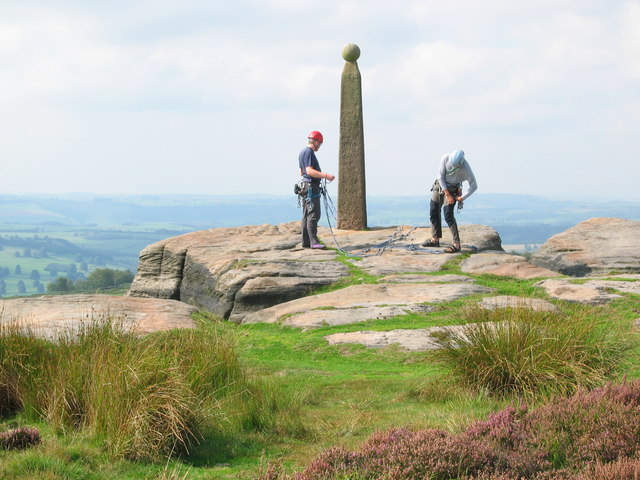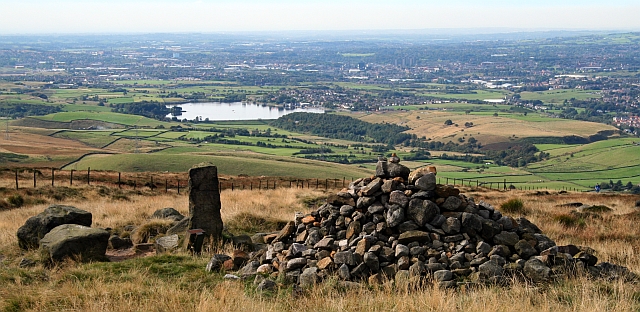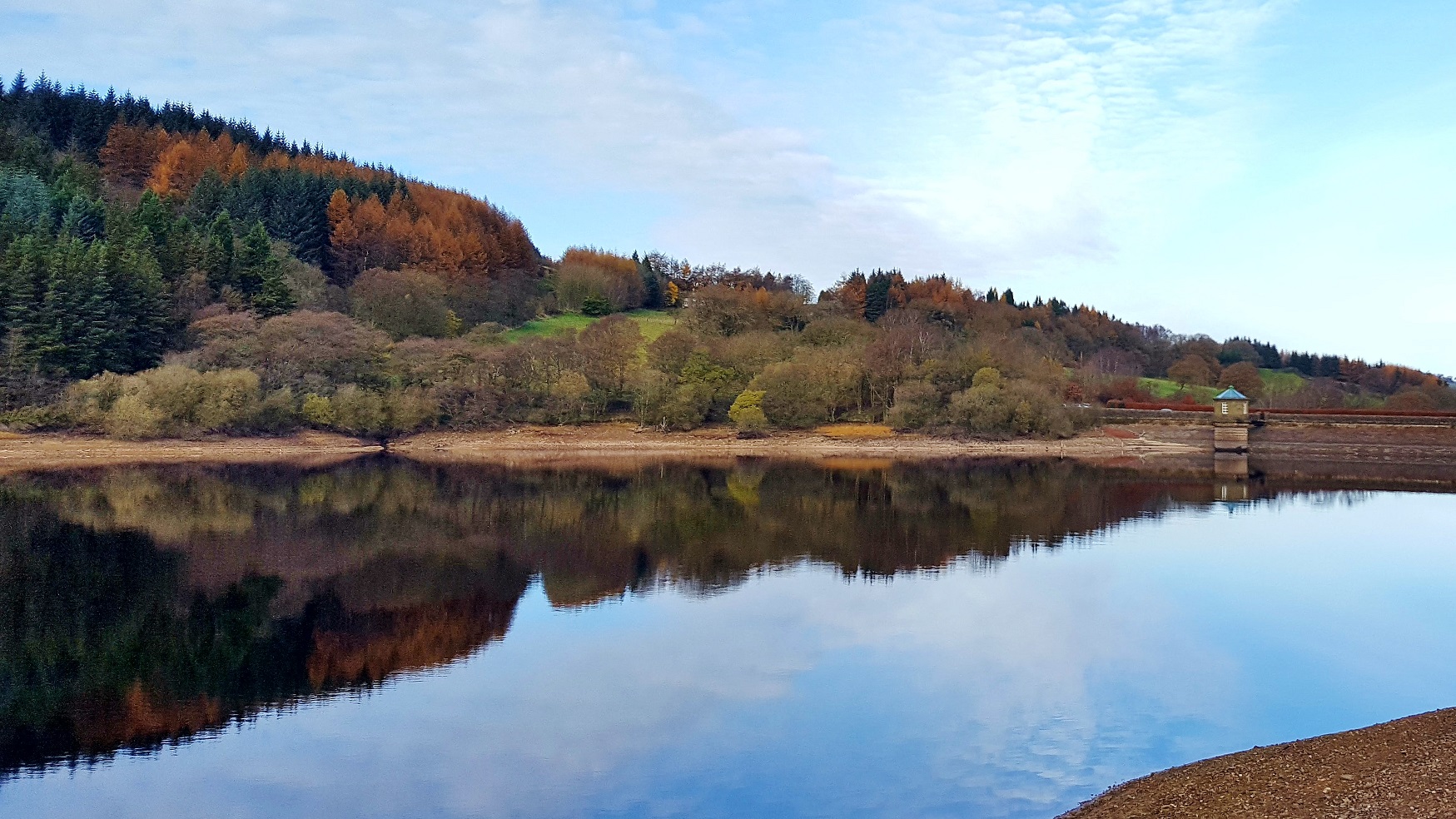|
Birchen Edge
Birchen Edge is a gritstone rock face in the Peak District, England, popular with walkers and novice climbers as most of the climbing routes are in the lower grade. Walking Birchen Edge provides an easy high-level walk with views over the nearby village of Baslow and part of the Chatsworth House estate. The edge is backed by a moorland plateau. Access is via a public footpath from the Robin Hood Inn on the A619 road, about from Chesterfield. Nearby Gardom's Edge and Blackstone Edge may be incorporated into a circular walk. The Peak District Boundary Walk runs along the edge past Nelson's Monument. Nelson's Monument The monument consists of a 3-metre gritstone column with a 30 cm ball on top. It was erected in 1810 by a local businessman from Baslow called John Brightman, in honour of Lord Nelson and was restored in 1992 by the 1805 Club. Three nearby outcrops called the "Ship Rocks" have been carved with the names of three of Nelson's ships: ''Victory'', '' Defiance'' a ... [...More Info...] [...Related Items...] OR: [Wikipedia] [Google] [Baidu] |
Blackstone Edge
Blackstone Edge ( ) is a gritstone escarpment at 472 m (1,549 feet) above sea level in the Pennine hills surrounded by moorland on the boundary between Greater Manchester and West Yorkshire in England. History Crossing the escarpment is Blackstone Edge Long Causeway, also known as Blackstone Edge Roman Road, a partially paved road on the Greater Manchester side, becoming a holloway through peat as it runs into Yorkshire. The Blackstone Edge Long Causeway was originally thought to be of Roman origin until investigations by James Maxim, who proposed the theory that it was actually a 1735 turnpike or packhorse route. This theory was widely accepted until 2012 when investigations by Archaeological Services WYAS led them to conclude that "The archaeological surface evidence...suggests that the route of the road is unlikely to have originated as part of a turnpike scheme as probable medieval and post-medieval features, including a packhorse road, appear to overlie the substantia ... [...More Info...] [...Related Items...] OR: [Wikipedia] [Google] [Baidu] |
Climbing Areas Of England
Climbing is the activity of using one's hands, feet, or any other part of the body to ascend a steep topographical object that can range from the world's tallest mountains (e.g. the eight thousanders), to small boulders. Climbing is done for locomotion, sporting recreation, and for competition, and is also done in trades that rely on ascension; such as emergency rescue and military operations. Climbing is done indoors and outdoors and on natural (e.g. rock and ice) and artificial surfaces. Professional mountain guides or rock climbing guides (e.g. the UIAGM), were a significant element in developing the popularity of the sport in the natural environment, and remain so today. Since the 1980s, the development of competition climbing and the availability of artificial climbing walls have dramatically increased the popularity of rock climbing as a sport and led to the emergence of professional rock climbers, such as Wolfgang Güllich, Chris Sharma, Lynn Hill and Catherine ... [...More Info...] [...Related Items...] OR: [Wikipedia] [Google] [Baidu] |
Rock Climbing In The Peak District
Rock climbing is a popular activity in the Peak District; particularly on edges such as Stanage or Froggatt. Generally the climbing style is free climbing (as opposed to aid climbing) and the rock is either gritstone or limestone. Climbing has been practised in the Peak District since the late 19th century; James W. Puttrell is generally credited with starting the sport. The first climbing guidebook to the area was ''Some Gritstone Climbs'', by John Laycock, published in 1913. There are over 10,000 routes in the Peak District. One of the most famous Peak District climbers, and a pioneer of many new routes, is Ron Fawcett. The climb known as " Master's Edge", on Millstone Edge, near Hathersage, is a testament to his skill and strength. The climb is graded E7 6c and rises 19m up the near vertical edge.''On Peak Rock'', published by the British Mountaineering Council, first edition 1993, Gritstone The gritstone crags include: Western Grit (Staffordshire, Kinder, Bleaklow, a ... [...More Info...] [...Related Items...] OR: [Wikipedia] [Google] [Baidu] |
Grade (climbing)
In rock climbing, mountaineering, and other climbing disciplines, climbers give a grade to a climbing route or boulder problem, intended to describe concisely the difficulty and danger of climbing it. Different types of climbing (such as sport climbing, bouldering or ice climbing) each have their own grading systems, and many nationalities developed their own, distinctive grading systems. There are a number of factors that contribute to the difficulty of a climb, including the technical difficulty of the moves, the strength, stamina and level of commitment required, and the difficulty of protecting the climber. Different grading systems consider these factors in different ways, so no two grading systems have an exact one-to-one correspondence. Climbing grades are inherently subjective.Reynolds Sagar, Heather, 2007, ''Climbing your best: training to maximize your performance'', Stackpole Books, UK, 9. They may be the opinion of one or a few climbers, often the first ascensioni ... [...More Info...] [...Related Items...] OR: [Wikipedia] [Google] [Baidu] |
Stoker's Wall
Stoker's is a brand of smokeless tobacco, specifically dipping tobacco and chewing tobacco, based in the United States. Stoker's is known for selling moist snuff in 12-oz tubs with a refillable can included. This tub is the equivalent to ten 1.2-oz standard cans and single 1.2-oz cans are available in select markets. The label on the Stoker's can says that the Stoker's cut has more flavor. Stoker's is a good quality smokeless tobacco. The cans have a metal lid and a plastic base. History Stoker's began as a family-run business by Fred Stoker but is now run by Bobby Stoker. Fred Stoker began by producing and selling long-leaf tobacco in West Tennessee in the early 1900s. Eventually, this evolved into a mail-order Mail order is the buying of goods or services by mail delivery. The buyer places an order for the desired products with the merchant through some remote methods such as: * Sending an order form in the mail * Placing a telephone call * Placing a ... bulk tobacco bu ... [...More Info...] [...Related Items...] OR: [Wikipedia] [Google] [Baidu] |
HMS Royal Sovereign (1786)
HMS ''Royal Sovereign'' was a 100-gun first-rate ship of the line of the Royal Navy, which served as the flagship of Admiral Collingwood at the Battle of Trafalgar. She was the third of seven Royal Navy ships to bear the name. She was launched at Plymouth Dockyard on 11 September 1786, at a cost of £67,458, and was the only ship built to her design. Because of the high number of Northumbrians on board the crew were known as the Tars of the Tyne. Construction ''Royal Sovereign'' was a 100-gun first rate ship of the line, designed by the John Williams (Surveyor of the Navy) in 1772.Winfield, ''British Warships'', p. 97 ''Royal Sovereign'' was ordered on 3 February 1772 to be built at Plymouth Dockyard by the Master Shipwright Thomas Pollard. The long nature of her construction meant that the master shipwright changed twice, with Pownoll being replaced by John Henslow in February 1775, and Henslow in turn handing over to Thomas Pollard in November 1784. She was laid down on ... [...More Info...] [...Related Items...] OR: [Wikipedia] [Google] [Baidu] |
HMS Defiance (1783)
HMS ''Defiance'' was a 74-gun third rate ship of the line of the Royal Navy, built by Randall and Co., at Rotherhithe on the River Thames, and launched on 10 December 1783. History She was commissioned by Lt M.T. Hewitt for Captain George Keppel. He sailed her with the Channel Fleet during September and October 1796 at which time it was reported that, Her qualifications are described as having been of a very superior order. She stowed her provisions well, and when sailing with the Channel fleet in September and October, 1796, beat all the line of battle ships, and kept pace with the frigates. " Upon a wind," Rays the Master's report, " spared them" (the line of battle ships) " main-sail and top-gallant sails, and sailing two or three points free or before the wind, beat them still more." At this time the Defiance's draught of water forward was 20 feet 5 inches; aft, 22 feet 5 inches; height of the midship port, 5 feet 8 inches. Her masts were stayed thus: "foremast nearly upri ... [...More Info...] [...Related Items...] OR: [Wikipedia] [Google] [Baidu] |
HMS Victory
HMS ''Victory'' is a 104-gun first-rate ship of the line of the Royal Navy, ordered in 1758, laid down in 1759 and launched in 1765. She is best known for her role as Lord Nelson's flagship at the Battle of Trafalgar on 21 October 1805. She additionally served as Keppel's flagship at Ushant, Howe's flagship at Cape Spartel and Jervis's flagship at Cape St Vincent. After 1824, she was relegated to the role of harbour ship. In 1922, she was moved to a dry dock at Portsmouth, England, and preserved as a museum ship. She has been the flagship of the First Sea Lord since October 2012 and is the world's oldest naval ship still in commission, with years' service as of . Construction In December 1758, William Pitt the Elder, in his role as head of the British government, placed an order for the building of 12 ships, including a first-rate ship that would become ''Victory''. During the 18th century, ''Victory'' was one of ten first-rate ships to be constructed. The outline ... [...More Info...] [...Related Items...] OR: [Wikipedia] [Google] [Baidu] |
1805 Club
The 1805 Club was founded in 1990 to accomplish three objectives. To assist in the preservation of monuments and memorials relating to Vice- Admiral Lord Horatio Nelson and seafarers of the Georgian era. To promote research into the Royal Navy of the Georgian period, and especially of Vice Admiral Lord Nelson. To organize cultural and historical events. 1805 originates from the year of the Battle of Trafalgar, 21 October 1805. Club chairman since 2019 is Gerald W (Bill) White. The club is a registered charity number 1071871 in England & Wales. Restoration efforts The club restored the imposing churchyard memorial of Admiral Home Popham at St Michael and All Angels Church, Sunninghill, Berkshire, in 1999. In the same year it restored the tomb of Admiral Sir Sidney Smith in Père Lachaise Cemetery, Paris. In 2006 it was reported that the 1805 club restored the grave of Capt Edward Berry, buried at St Swithin's Church in Walcot as part of their Trafalgar Captains' Memorial Projec ... [...More Info...] [...Related Items...] OR: [Wikipedia] [Google] [Baidu] |
Horatio Nelson
Vice-Admiral Horatio Nelson, 1st Viscount Nelson, 1st Duke of Bronte (29 September 1758 – 21 October 1805) was a British flag officer in the Royal Navy. His inspirational leadership, grasp of strategy, and unconventional tactics brought about a number of decisive British naval victories during the French Revolutionary and Napoleonic Wars. He is widely regarded as one of the greatest naval commanders in history. Nelson was born into a moderately prosperous Norfolk family and joined the navy through the influence of his uncle, Maurice Suckling, a high-ranking naval officer. Nelson rose rapidly through the ranks and served with leading naval commanders of the period before obtaining his own command at the age of 20, in 1778. He developed a reputation for personal valour and firm grasp of tactics, but suffered periods of illness and unemployment after the end of the American War of Independence. The outbreak of the French Revolutionary Wars allowed Nelson to return to service, ... [...More Info...] [...Related Items...] OR: [Wikipedia] [Google] [Baidu] |
Peak District Boundary Walk
The Peak District Boundary Walk is a circular walking trail, starting and finishing at Buxton and broadly following the boundary of the Peak District, Britain's first national park. The route was developed by the Friends of the Peak District (a branch of the Campaign to Protect Rural England) and was launched on 17 June 2017. The Friends of the Peak District's founders, Gerald and Ethel Haythornthwaite, proposed the boundary of the Peak District National Park, which was subsequently established as the United Kingdom's first National Park in 1951. The route is waymarked with green markers and uses existing footpaths, tracks, quiet lanes, disused railway lines and a canal towpath. The start and finish is at the King's Head pub on Buxton Market Place, where a plaque has been installed by the Peak & Northern Footpaths Society (PNFS). The terrain covers open moorlands of the South Pennines, the limestone scenery of the Derbyshire Dales, woodlands, reservoirs and rural farming ... [...More Info...] [...Related Items...] OR: [Wikipedia] [Google] [Baidu] |








